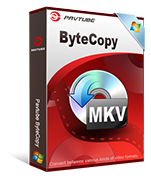Jul 05, 2016 05:26 am / Posted by Diana Joan | Categories: Blu-ray
People often rip Blu-rays with Makemkv. However, sometimes, they found that they couldn’t play their Blu-ray MKV rips even in the powerful Kodi. Why? That’s because some Blu-rays are encoded with AC-1 instead of AVC/h.264. Many devices and media player can’t stream AC-1 Blu-rays.
“I’ve been watching latelly some early releases from Warner Bros. and Universal on BD, which used the VC1 codec for video. I remember there was talking some years ago that VC1 was inferior to AVC, that VC1 uses to soften picture and was only efficient on low data rates (as with HD-DVD, many early Warner HD-DVD and BD shared the same encode) but AVC renders more picture quality and that’s why VC1 was almost abandoned. Your opinion on this subject?” – from forums.stevehoffman.tv
“Kodi 14.2 Helix, a tv box with amlogic s805+ android 4.4.2 with 1GB ram, branded MXQ. It’s pretty good(no problem) when I play “Blade Runner” final cut blu-ray(VC-1 AP@L3), but when I play “Inception”(same VC-1 AP@L3), it’s pretty laggy… what’s wrong, guys? Isn’t VC-1 hardware decoded already by S805 and well support by Kodi?” – from forum.kodi.tv
“I know AVC was developed by Sony, and VC-1 was developed by Microsoft. What is the difference between the two, which is more efficient right now?” – From forum.blu-ray.com
Many people don’t know what is AC-1 or AVC (H.264) and the difference between the two. So here we will explain it to you and compare VC-1 with AVC
What is AC-1?
SMPTE 421M, informally known as VC-1, is a video coding format. It was initially developed as the proprietary video format Windows Media Video 9 by Microsoft in 2003 and officially approved as a SMPTE video codec standard on April 3, 2006. It is today a supported standard found in Blu-ray Discs, Microsoft’s Silverlight framework, and the now-discontinued HD DVD.
VC-1 is an evolution of the conventional DCT-based video codec design also found in H.261, MPEG-1 Part 2, H.262/MPEG-2 Part 2, H.263, and MPEG-4 Part 2. It is widely characterized as an alternative to the ITU-T and MPEG video codec standard known as H.264/MPEG-4 AVC. VC-1 contains coding tools for interlaced video sequences as well as progressive encoding. The main goal of VC-1 Advanced Profile development and standardization was to support the compression of interlaced content without first converting it to progressive, making it more attractive to broadcast and video industry professionals.
Both HD DVD and Blu-ray Disc have adopted VC-1 as a video standard, meaning their video playback devices will be capable of decoding and playing video-content compressed using VC-1. Windows Vista partially supports HD DVD playback by including the VC-1 decoder and some related components needed for playback of VC-1 encoded HD DVD movies. – source from wikipedia.
What is H.264/MPEG-4 AVC?
H.264 or MPEG-4 Part 10, Advanced Video Coding (MPEG-4 AVC) is a block-oriented motion-compensation-based video compression standard that is currently one of the most commonly used formats for the recording, compression, and distribution of video content. The intent of the H.264/AVC project was to provide enough flexibility to allow the standard to be applied to a wide variety of applications on a wide variety of networks and systems, including low and high bit rates, low and high resolution video, broadcast, DVD storage, RTP/IP packet networks, and ITU-T multimedia telephony systems.
H.264 is perhaps best known as being one of the video encoding standards for Blu-ray Discs; all Blu-ray Disc players must be able to decode H.264. It is also widely used by streaming internet sources, such as videos from Vimeo, YouTube, and the iTunes Store, web software such as the Adobe Flash Player and Microsoft Silverlight, and also various HDTV broadcasts over terrestrial, cable, and satellite. – source from wikipedia
Comparison of H.264/AVC and VC-1
H.264/AVC and VC-1 are popular video compression standards
Overview
| VC-1 | H.264/AVC | |
| Goals | Designed to offer very high image quality with excellent compression efficiency | Designed to meet a variety of industry needs with many profiles and levels, allowing for varying compression, quality and CPU usage levels, where the lowest level is for portable devices, designed with low CPU usage in mind, while the high levels are designed with very high quality and compression efficiency in mind |
| Example industry use | Supports 4:2:0 compression / color space | Supports studio archiving requirements with 4:4:4 color space;separate black and white (BW) video mode |
| Licensing costs | Similar | |
| Documentation | Not free. Reference decoder, comes with external documentation. | AVC/H264 Licensing costs and terms from MPEG LA. Reference encoder and decoder free as well. Additionally, JVT & M4IF mailing lists are available where one may receive answers on AVC related questions. |
Terminology
All sources for the below information are from the respective specifications listed in the overview section.
| Feature | VC-1 | H.264/AVC |
|---|---|---|
| Partition sizes | 16×16 and 8×8 | 16×16, 16×8, 8×16, 8×8, 8×4, 4×8, and 4×4 |
| Integer transform | 8×8, 4×8, 8×4, and 4×4 | 4×4; 8×8 available in High Profile only |
| Frame | Used for progressive or interlaced content | |
| Macroblock sizes | 16×16 only | |
| Motion vector | Two dimensional vector offset from current position to reference frame | |
| Picture | A field or frame | |
| Skipped macroblock | No data is encoded for macroblock | |
Features
| VC-1 | H.264/AVC | |
| Bitstream formats | single bit stream | NAL and byte stream |
| Bitstream format | In advanced profile, each Bitstream Data Unit has its own header.Simple and Main profile provide neither sequence nor entry point headers. | SPS (sequence parameter set),PPS (picture parameters set),slice header, macroblock |
| Deblocking filter | In-loop filter and overlap transform | In-loop only |
| CABAC | No | Only supported in Main and higher profiles |
| Variable transform size | Yes | Only in High profile and above |
| Slice | Contiguous (integer number of macroblock rows only) | Contiguous or non-contiguous |
| Sub-pixel interpolation methods | bicubic, bilinear | 6-tap filter for half pixels; averaging for quarter pixels |
| Variable Length Coding | Yes | |
| B frame used for predicting other pictures | Yes | |
Blu-ray Ripper to Rip AC-1 and AVC Blu-ray
Not every Blu-ray ripping tool can rip not Blu-ray encoded with AVC but also AC-1 Blu-ray. During the experiment, we tried several different Blu-ray ripping tools and found that tools like MeGUI,Handbrake, and BD Rebuilder struggle with the VC-1 video files, reporting that conversion will take over three days for a 2 hour movie. So, is there something to do with the VC-1 codec smoothly with the best resulted video? Fortunately, when we tired Pavtube ByteCopy, it works with the VC-1 encoded Blu-ray perfectly.
Overall, it facilitates removing region code and ripping the content of any VC-1 and AVC encoded Blu-rays (encrypted or not encrypted) to H.265, H.264 MP4, MKV, AVI, etc. in several clicks with original wonderful quality and keep 5.1 channels. Moreover, it supports Blu-ray disc decryption (crack AACS, BD+, region code, copyright protection) and lists the titles/chapters when loading Blu-ray disc. And it is easy enough to backup Blu-ray without protection and copy Blu-ray to MKV with lossless video output and multiple audio & subtitle & chapter markers with 7.1 sound preserving. This following text will take this program for example to introduce the steps to convert and rip VC1 and AVC Blu-ray to H.264 for Open Hour Chameleon, Himedia Q10, Kodi, Roku, Nvidia Shield. If you wanna process VC1 and AVC Blu-ray on Mac OS X (El Capitan inlcuded), please turn to ByteCopy for Mac.
Free download and install Pavtube ByteCopy:


1. Run the Blu-ray Ripper and import VC-1 and AVC encoded Blu-ray content. Soon after loading, you will find all titles and chapters for the Blu-ray disc. You can select preferred subtitles and audio track.

2. Click Format bar and select output format. To convert BD AVC/VC-1 to H.264 MP4, MKV, AVI, you can select from “HD Video” profile.
Tip: If you wanna play the output videos on certain devices, a better choice is selecting the preset for device like TV as the output format in the output box.
3. This VC-1 Blu-ray Converter for VC-1 encoded also allows you to customize video and audio parameters via clicking Settings button. The adjustable settings include codec, bit rate, frame rate, sample rate, audio channel.
4. When all the settings are ready, hit the Convert button to start ripping Blu-ray VC1 and AVC to H.264 for VC-1 encoded. Once the conversion is finished, you can click “Open” button to find the final output video for streaming to TV effortlessly.
Related Aricles:
Related Articles
Hot Articles & Reviews
- Top 3 DVD Movie Subtitle Editors
- Best DVD to MP4 Converter Review
- Top 5 Best Free DVD Ripper
- Top 10 Free DVD Ripper Reviews
- Top 3 DVD to MKV Rippers for MacOS Sierra
Any Product-related questions?










Leave a reply